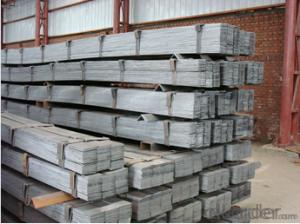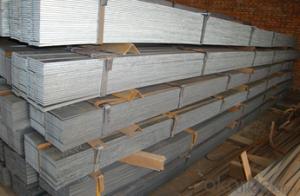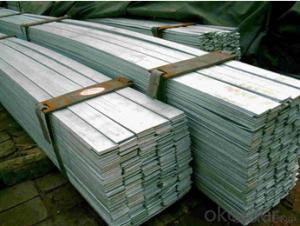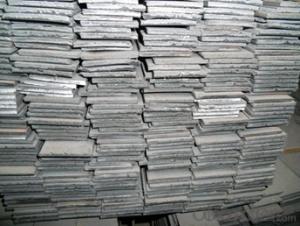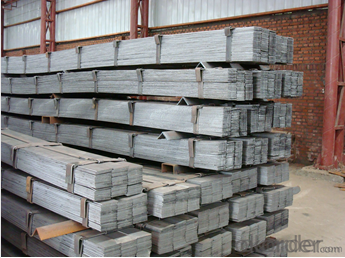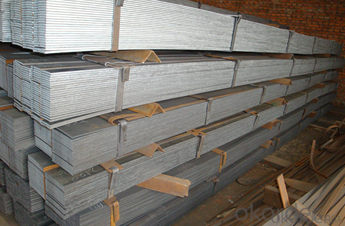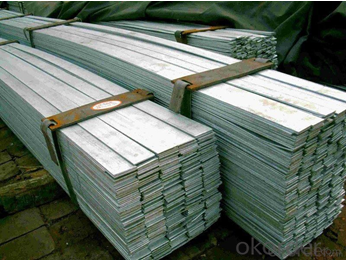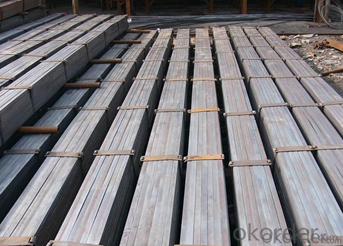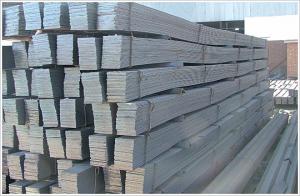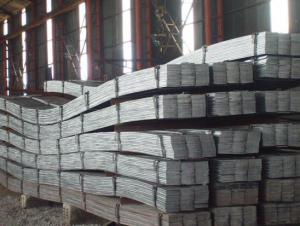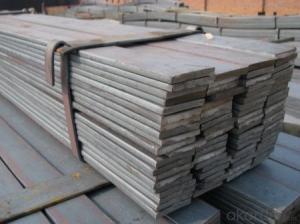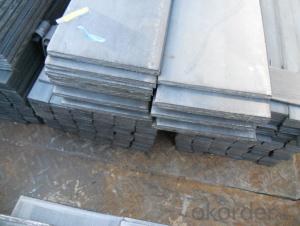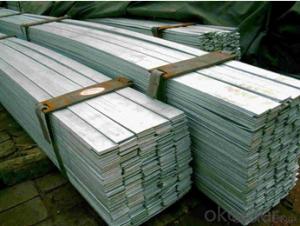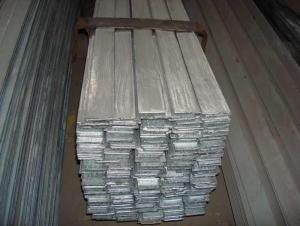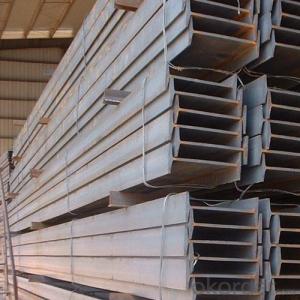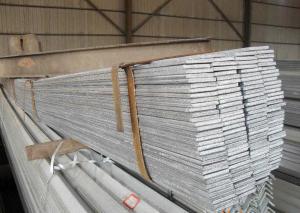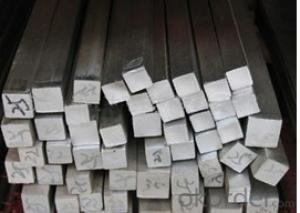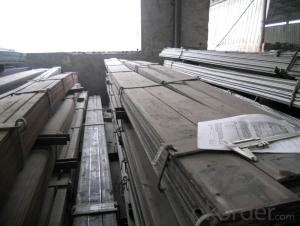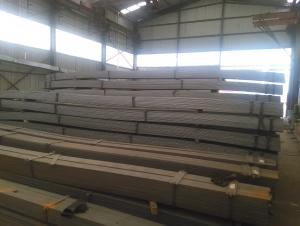Galvanized Flat Bar with Length: 6m, 12m
- Loading Port:
- Tianjin
- Payment Terms:
- TT OR LC
- Min Order Qty:
- 50 m.t.
- Supply Capability:
- 1000 m.t./month
OKorder Service Pledge
OKorder Financial Service
You Might Also Like
Product Description:
OKorder is offering Galvanized Flat Bar with Length: 6m, 12m at great prices with worldwide shipping. Our supplier is a world-class manufacturer of steel, with our products utilized the world over. OKorder annually supplies products to European, North American and Asian markets. We provide quotations within 24 hours of receiving an inquiry and guarantee competitive prices.
Product Applications:
Hot Rolled Steel I-Beams are ideal for structural applications and are widely used in the construction of buildings and bridges, and the manufacturing, petrochemical, and transportation industries.
Product Advantages:
OKorder's Galvanized Flat Bar are durable, strong, and resist corrosion.
Main Product Features:
Premium quality
Prompt delivery & seaworthy packing (30 days after receiving deposit)
Corrosion resistance
Can be recycled and reused
Mill test certification
Professional Service
Competitive pricing
Specifications of Galvanized Flat Bar
1. Invoicing on theoretical weight or actual weight as customer request
2. Length: 6m, 12m as following table
3. Sizes:
Galvanized Flat Bar Zinc Thickness:15-80μ
Grade: A36, SS400, Q235, Q195
Standard: ASTM, JIS, GB
Thickness:1.5mm-20mm
Width: 10mm-250mm
Width | Thickness | Width | Thickness | Width | Thickness |
(mm) | (mm) | (mm) | (mm) | (mm) | (mm) |
8 | 5-7 | 50 | 5-25 | 200 | 8-40 |
10 | 3-9 | 55 | 5-25 | 220 | 8-40 |
12 | 3-9 | 60 | 5-25 | 250 | 8-40 |
13 | 5-11 | 65 | 5-25 | 260 | 8-40 |
14 | 3-12 | 70 | 5-25 | 270 | 8-40 |
15 | 5-12 | 75 | 5-25 | 280 | 8-40 |
16 | 4-14 | 80 | 6-25 | 290 | 8-40 |
18 | 4-16 | 85 | 6-25 | 300 | 8-40 |
20 | 4-18 | 90 | 6-25 | 310 | 8-40 |
22 | 4-20 | 95 | 6-25 | 320 | 8-40 |
24 | 5-20 | 100 | 6-25 | 330 | 8-40 |
25 | 4-20 | 105 | 6-25 | 340 | 8-40 |
28 | 4-20 | 110 | 6-25 | 350 | 8-40 |
30 | 4-25 | 120 | 7-25 | 360 | 8-40 |
32 | 4-25 | 125 | 7-25 | 370 | 8-40 |
35 | 4-25 | 130 | 8-25 | 380 | 8-40 |
36 | 6-25 | 140 | 8-25 | 390 | 8-40 |
38 | 7-25 | 150 | 8-25 | 400 | 8-40 |
40 | 4-25 | 160 | 8-40 | ||
45 | 4-25 | 180 | 8-40 |
5. Material Specifications:
Production Standard: GB/T 700-2006 | |||||
Grade | Chemical composition (%,max) | ||||
C | Si | Mn | P | S | |
Q195 | 0.12 | 0.30 | 0.50 | 0.035 | 0.040 |
Q235A | 0.22 | 0.35 | 1.40 | 0.045 | 0.050 |
Q235B | 0.20 | 0.35 | 1.40 | 0.045 | 0.045 |
Q235C | 0.17 | 0.35 | 1.40 | 0.040 | 0.040 |
Q235D | 0.17 | 0.35 | 1.40 | 0.035 | 0.035 |
Q235 is similar to ASTMA36,JIS SS400
Usage & Applications of Galvanized Flat Bar
Widely used for construction,Fabrication , Ship building, Machinery manufacturing, Steel structure
Packaging & Delivery of Galvanized Flat Bar
1. Packing: it is nude packed in bundles by steel wire rod
2. Bundle weight: not more than 3.5MT for bulk vessel; less than 3 MT for container load
3. Marks:
Color marking: There will be color marking on both end of the bundle for the cargo delivered by bulk vessel. That makes it easily to distinguish at the destination port.
Tag mark: there will be tag mark tied up on the bundles. The information usually including supplier logo and name, product name, made inChina, shipping marks and other information request by the customer.
If loading by container the marking is not needed, but we will prepare it as customer request.
4. Transportation: the goods are delivered by truck from mill to loading port, the maximum quantity can be loaded is around 40MTs by each truck. If the order quantity cannot reach the full truck loaded, the transportation cost per ton will be little higher than full load.
5. Delivered by container or bulk vessel
Production flow of Galvanized Flat Bar
The process of hot-dip galvanizing results in a metallurgical bond between zinc and steel with a series of distinct iron-zinc alloys. The resulting coated steel can be used in much the same way as uncoated.
A typical hot-dip galvanizing line operates as follows:
Steel is cleaned using a caustic solution. This removes oil/grease, dirt, and paint.
The caustic cleaning solution is rinsed off.
The steel is pickled in an acidic solution to remove mill scale.
The pickling solution is rinsed off.
A flux, often zinc ammonium chloride is applied to the steel to inhibit oxidation of the cleaned surface upon exposure to air. The flux is allowed to dry on the steel and aids in the process of the liquid zinc wetting and adhering to the steel.
The steel is dipped into the molten zinc bath and held there until the temperature of the steel equilibrates with that of the bath.
The steel is cooled in a quench tank to reduce its temperature and inhibit undesirable reactions of the newly formed coating with the atmosphere.
FAQ:
Q1: Why buy Materials & Equipment from OKorder.com?
A1: All products offered byOKorder.com are carefully selected from China's most reliable manufacturing enterprises. Through its ISO certifications, OKorder.com adheres to the highest standards and a commitment to supply chain safety and customer satisfaction.
Q2: How do we guarantee the quality of our products?
A2: We have established an advanced quality management system which conducts strict quality tests at every step, from raw materials to the final product. At the same time, we provide extensive follow-up service assurances as required.
Q3: How soon can we receive the product after purchase?
A3: Within three days of placing an order, we will begin production. The specific shipping date is dependent upon international and government factors, but is typically 7 to 10 workdays.

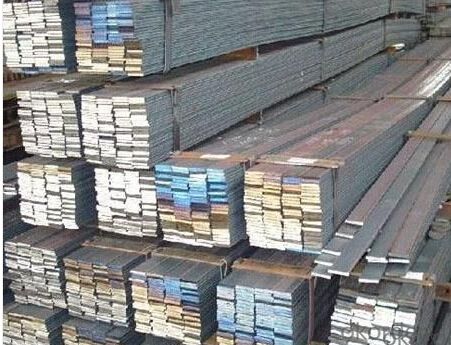
- Q: Can steel flat bars be used for fencing or security purposes?
- Yes, steel flat bars can be used for fencing or security purposes. Steel flat bars are strong and durable, making them suitable for creating sturdy and secure barriers. They can be used to construct perimeter fences, gates, or security grilles to protect properties, commercial buildings, or restricted areas. Steel flat bars can be welded, bolted, or mounted to create a solid and impenetrable structure. Additionally, they can be customized to various heights, lengths, and designs to meet specific security requirements. Their resistance to corrosion and weathering also ensures long-lasting performance, making steel flat bars an excellent choice for fencing and security applications.
- Q: What is the tensile force of the galvanized flat steel of 20*3?
- According to "hot rolled flat steel size, shape, weight and allowable deviation", GB 704-88:Ordinary class allows upper deviation +0.3mm, lower deviation -0.5mm; higher allowed upper deviation +0.2mm, lower deviation -0.4mm, the upper deviation is not to think, do not exceed the next deviation is good.
- Q: What are the dimensions of a standard steel flat bar?
- The dimensions of a standard steel flat bar typically vary depending on the manufacturer and the specific application. However, common dimensions for a standard steel flat bar range from 1/8 inch to 1 inch in thickness and 1/2 inch to 12 inches in width. The length of the bar can vary but is often around 20 feet.
- Q: How do you determine the maximum load capacity of a steel flat bar?
- The maximum load capacity of a steel flat bar can be determined through a combination of engineering calculations and testing. Firstly, the material properties of the specific steel alloy used in the flat bar need to be known, such as its yield strength and ultimate tensile strength. These properties can be obtained from the material manufacturer or reference sources. With the material properties in hand, engineering calculations can be performed to determine the maximum load the flat bar can handle before it reaches its yield strength or ultimate tensile strength. Factors like the cross-sectional area and length of the flat bar, as well as the type of load (e.g., bending, tension, compression), must be considered in these calculations. To validate the calculated maximum load capacity, physical testing is often conducted. This involves subjecting the steel flat bar to gradually increasing loads until it deforms or fractures. The maximum load at which the bar remains intact is then considered its load capacity. Ultimately, determining the maximum load capacity of a steel flat bar requires a combination of theoretical calculations and experimental testing to ensure accurate and reliable results.
- Q: What are the different certifications and standards for steel flat bars?
- There are various certifications and standards for steel flat bars, including ASTM (American Society for Testing and Materials) standards such as A36, A572, and A36/A572-50, which specify the chemical composition and mechanical properties of the steel. Additionally, there are international standards such as EN 10025, which is the European standard for structural steel. Other certifications and standards may include ISO 9001 for quality management systems, ISO 14001 for environmental management systems, and OHSAS 18001 for occupational health and safety management systems.
- Q: What are the common defects found in steel flat bars?
- Some common defects found in steel flat bars include surface imperfections such as scratches, pitting, and scaling. These defects can occur during the manufacturing process or during handling and transportation. Another common defect is warping, which can happen due to uneven cooling or improper storage. In addition, steel flat bars may have variations in dimensions such as width, thickness, and length, which can be considered defects if they fall outside the specified tolerances. It is important to inspect steel flat bars for these defects before using them in construction or other applications to ensure structural integrity and quality.
- Q: Are steel flat bars used in the manufacturing of medical equipment or devices?
- Yes, steel flat bars are commonly used in the manufacturing of medical equipment or devices. Steel is known for its strength, durability, and resistance to corrosion, making it an ideal material for various medical applications. Steel flat bars are often used to create structural components, supports, frames, and brackets for medical devices. These bars provide stability and support, ensuring the safe and efficient functioning of the equipment. Additionally, steel can be easily sterilized, making it suitable for use in sterile environments such as hospitals and clinics. Overall, steel flat bars play a crucial role in the manufacturing of medical equipment and devices, contributing to their reliability and longevity.
- Q: How do steel flat bars perform in terms of fire resistance?
- Steel flat bars have a high fire resistance due to their inherent non-combustible nature. They retain their structural integrity and do not contribute to the spread of fire, making them a reliable choice in fire-prone environments.
- Q: What are the advantages of using alloy steel flat bars?
- Alloy steel flat bars possess numerous benefits. Firstly, they are renowned for their exceptional strength and durability. By combining various metals, such as chromium, nickel, and molybdenum, with iron, alloy steel flat bars become significantly stronger and more resistant to wear and tear when compared to ordinary steel. Consequently, they are ideal for industries requiring superior strength and toughness, such as construction, manufacturing, and engineering. Secondly, alloy steel flat bars exhibit remarkable corrosion resistance properties. The inclusion of elements like chromium enhances their ability to withstand rust and corrosion, rendering them suitable for environments with high moisture levels or exposure to chemicals. As a result, the lifespan of these flat bars is considerably prolonged, thereby reducing the need for frequent maintenance or replacements. Moreover, alloy steel flat bars offer versatility in terms of their applications. They can be easily machined, welded, and molded into various shapes and sizes, allowing for customization to specific project requirements. This adaptability renders them suitable for a broad range of uses, including structural supports, machinery components, tools, and automotive parts. Furthermore, the high temperature resistance of alloy steel flat bars provides another advantage. They can endure elevated temperatures without compromising their strength or structural integrity. Consequently, they are well-suited for industries involving high heat, such as aerospace, energy, and power generation. Lastly, alloy steel flat bars offer cost-effectiveness. Although they may entail a higher initial cost compared to regular steel, their durability and longevity make them a cost-effective choice in the long run. Their resistance to wear, corrosion, and deformation minimizes the need for frequent replacements, repairs, and maintenance, ultimately saving both time and money. In conclusion, alloy steel flat bars possess numerous advantages, including high strength, durability, corrosion resistance, versatility, high temperature resistance, and cost-effectiveness. These properties establish them as a dependable and efficient option for a wide range of applications in various industries.
- Q: Are steel flat bars suitable for welding projects?
- Indeed, welding projects find steel flat bars to be a fitting choice. Owing to their adaptability and robustness, steel flat bars are frequently employed in welding endeavors. Their level surface facilitates ease of manipulation and welding, thereby enabling accurate and sturdy connections. With a range of sizes and thicknesses on offer, steel flat bars cater to diverse types of welding projects. Moreover, steel's renowned durability and heat resistance greatly contribute to welding. All in all, steel flat bars prove to be a dependable and widely utilized material in welding projects.
Send your message to us
Galvanized Flat Bar with Length: 6m, 12m
- Loading Port:
- Tianjin
- Payment Terms:
- TT OR LC
- Min Order Qty:
- 50 m.t.
- Supply Capability:
- 1000 m.t./month
OKorder Service Pledge
OKorder Financial Service
Similar products
Hot products
Hot Searches
Related keywords
